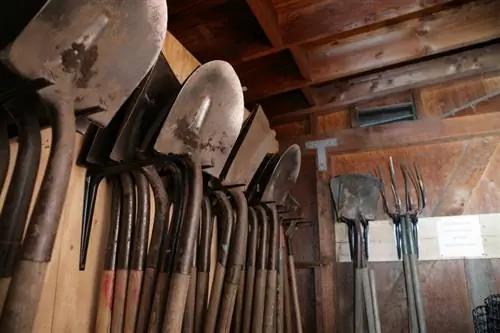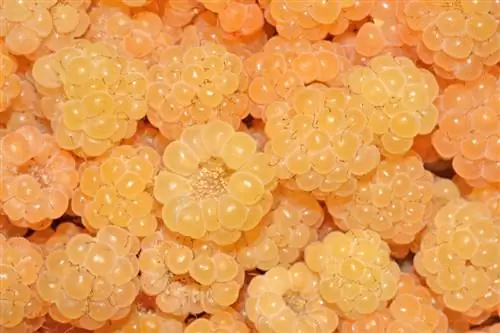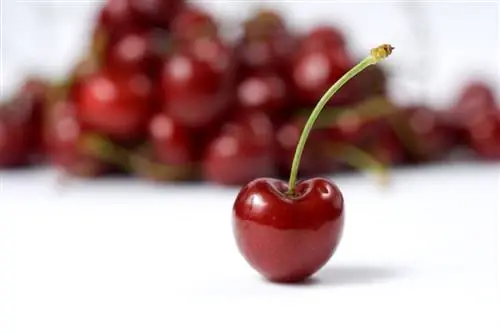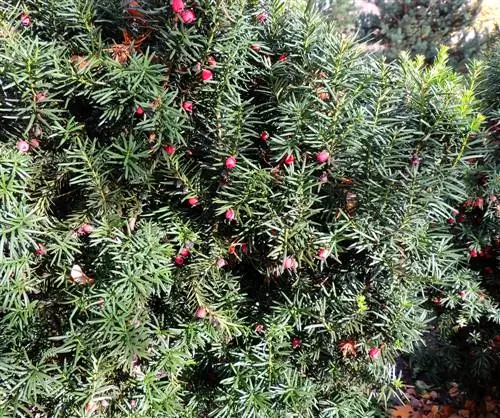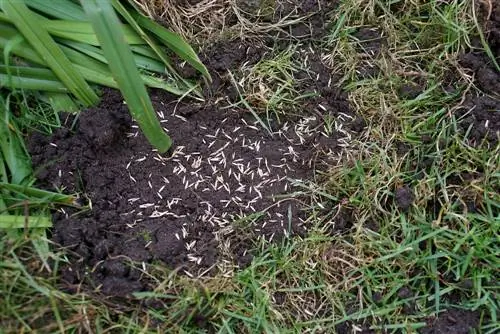- Author admin [email protected].
- Public 2023-12-16 16:46.
- Last modified 2025-01-23 11:21.
This post is in no way intended to present you with an inventory of your garden's tool shed. Rather, today it's about the most faithful companion between the vegetable beds, fruit trees and bushes for centuries - the spade. The indispensable devices were already used by people in the Stone Age and their form has been continually adapted to regional conditions ever since.
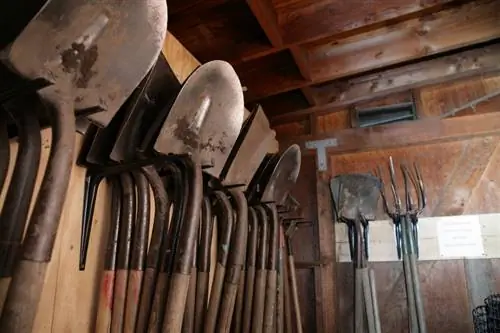
Which different spades are suitable for the garden?
Spades are essential garden tools and differ in shape, handle and leaf. The best-known types of spades include gardener's spades, Kieler spades, root spades, Holsteiner Rüffel and marching rüffels. The decisive factor when purchasing is to adapt it to regional soil conditions and ergonomic requirements such as back protection and fatigue-free working.
Generations later, the Romans were already gardening with forged spade blades. The first wooden spades finally became available in the 19th century. In between, there was a smooth transition to the shovel, which made the earthwork much easier, and not just in the garden. The fact that such fundamentally different spade shapes are used then as now is due to the adaptation of the implements to the different regional soil conditions, although there was also a little local patriotism at play and still is today.
Gardeners but also employees of the agricultural engineering guild always favored their regional variant as the unrivaled best and highest quality work tool. You still occasionally hear about this today, so there are quite a few different types of spades to choose from in hardware stores. Some of the most striking examples in short form:
- Gardener's spade: The traditional type in English form, which with its rounded cutting edge is mainly used in the private sector and in commercial nurseries; The T-shape of the handle, the so-called Krumpholz, is characteristic;
- Kieler Spaten: is suitable for stone, clay and marsh soils and can be recognized by the handle, which is shaped like a “D” on the inside; A special feature is its higher weight, which makes work much easier on difficult soils;
- Root spade: the very sharply ground blade is deeply cut at the bottom and is intended to enable effortless work, especially in heavily rooted soils; Digging planting areas is also comparatively easy with this Baack spade;
- Holsteiner Rüffel: a spade shape that is particularly popular in the north and is said to penetrate the soil particularly easily with its slightly conical metal blade; Another characteristic: the blade becomes noticeably thinner from the top towards the cutting edge;
- Marsh ruffel: significantly narrower leaf shape, which is intended to enable easy digging, especially on extremely heavy soils; is available in different handle lengths and handles;
What to consider when choosing
If possible, try out several variants at specialist retailers. Even if the conventional types with a precisely straight handle are cheaper in terms of price, it is worth testing one of the ergonomically designed spades. The seller probably won't let you dig in the market, but the weight and dimensions alone can give you an indication of the amount of sweat drops to expect and the degree of curvature of your spine. The curved design of the handles of top-class spades, like their different handle shapes (D, T and button handles), can contribute significantly to protecting your back and ensuring fatigue-free work.
To do this, however, you have to be prepared to hand over an almost three-digit euro amount at the garden center checkout. A widespread, but not always comprehensible, opinion of sales-concerned hardware store salespeople is that cheap spades (€29.00 on Amazon) make for tedious work. But there are also exceptions, as NDR discovered in a practical test in 2015. Since the innovation rate for garden tools of this type is not very high, this almost three-year-old comparison can still be used today to make a purchasing decision. The winner was not, as might be expected, the Ideal Spade, which cost 43.95 euros, but the much cheaper Lidl model at 12.99 euros. If you would like to read: “How well do cheap spades dig?” NDR from 11.05.2015.
Spade care also takes time
Even if you have decided on a hand-forged spade blade made of hardened quality steel, you should definitely not compromise on the care required. Therefore, please heed the following three tips, which are crucial for a really long lifespan of the most important garden utensil:
- Spade handles tend to become rough on their surface after a certain amount of time, which gradually leads to a noticeable decrease in the elasticity of the wood. A little sandpaper to smooth it and then a few drops of oil will help with a loss of grip and prevent the spade blade from loosening later.
- Adhering soil residues from the garden are better removed immediately and before they dry. A little lukewarm water and a not too hard brush are enough to keep your spade nice and clean and free from rust.
- Damage to the blade and handle should be repaired before the garden-free period in winter. Any small rust spots can be sanded off relatively thoroughly and are finally rubbed off with a cloth lightly soaked in oil.

